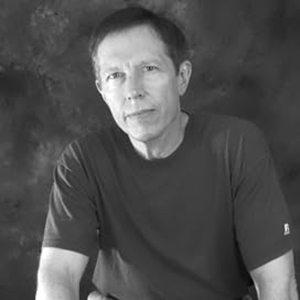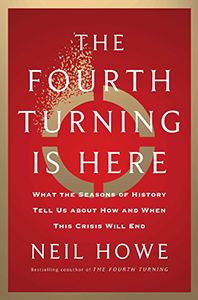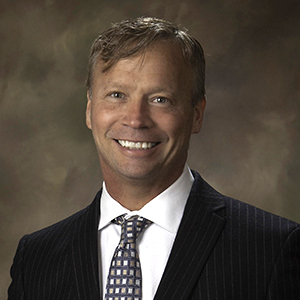Interview with Neil Howe


Neil Howe
author of "The Fourth Turning Is Here: What the Seasons of History Tell Us about How and When This Crisis Will End"

Michael Carter
Co-Host
Neil Howe, author of "The Fourth Turning Is Here: What the Seasons of History Tell Us about How and When This Crisis Will End"
Neil Howe's Website
A historian, economist, and demographer, Neil Howe is Managing Director of Demography at Hedgeye Risk Management, an independent financial research firm. He is best known for his analysis of generations and social change in America. An acclaimed bestselling author and speaker, he is the nation’s leading thinker on today’s generations—who they are, what motivates them, and how they will shape America’s future.
Howe is also a recognized authority on global aging, long-term fiscal policy, and migration. He is currently a senior associate at the Center for Strategic and International Studies (CSIS) and at the Global Aging Institute, both in Washington, DC. Howe has co-authored numerous studies for CSIS (including the Aging Vulnerability Index and pioneering studies on pension reform in China and South Korea).
Howe has written over a dozen books on generations, demographic change, and fiscal policy, many of them with William Strauss. Howe and Strauss’ first book, Generations (1991), is a history of America told as a sequence of generational biographies. Vice President Al Gore called it “the most stimulating book on American history that I have ever read” and sent a copy to every member of Congress. Newt Gingrich called it “an intellectual tour de force.” Of their book The Fourth Turning (1997), Dan Yankelovich said, “Immensely stimulating…We will never be able to think about history in the same way.” The Boston Globe wrote, “If Howe and Strauss are right, they will take their place among the great American prophets.”
In 2023 Neil Howe looks once again to America’s past to predict our future in his new book The Fourth Turning is Here with a startling and hopeful prophecy for how our present era of civic trauma will resolve over the next ten years—and what our lives will look like once it has.
Howe and Strauss originally coined the term “Millennial Generation” in 1991, and wrote the pioneering book on this generation, Millennials Rising (2000). His work has been featured frequently by media outlets including The Washington Post, The New York Times, CNN, and CBS’s 60 Minutes. Previous works include On Borrowed Time (1989; reissued 2004), a pioneering call for budgetary reform Howe coauthored with Peter G. Peterson, as well as The Graying of the Great Powers (2008) with Richard Jackson.
Howe grew up in California and currently resides in Great Falls, Virginia, close to Washington, DC. He received his B.A. at UC Berkeley, studied abroad in France and Germany, and later earned graduate degrees in economics (M.A., 1978) and history (M.Phil., 1979) from Yale University.
The Book: "The Fourth Turning Is Here: What the Seasons of History Tell Us about How and When This Crisis Will End"
ISBN: 1982173734
Get the bookOver the past decade, many Americans have developed a deep foreboding that their society has fallen into crisis. Ever-growing polarization, economic inequality and inflation have stoked a feeling on both the left and the right that the country’s once revered political institutions have become dysfunctional and illegitimate. Particularly since the Russian invasion of Ukraine, the crisis has taken on a geopolitical dimension, leading many to fear that the present is far more dangerous than any other period in their lifetimes. Worse, the path to safety is not clear; simply getting past the next election without the democratic system grinding to a halt seems like a big achievement.
Against this background we have the publications of Neil Howe’s “The Fourth Turning Is Here” and Peter Turchin’s “End Times.” Both books affirm the idea that we are in the midst of a major crisis and use history to predict how the crisis might be resolved. Both authors had predicted, by a decade or more, that a period of great crisis would arrive around 2020, though neither foresaw a pandemic.
Turchin is a former theoretical biologist and a self-described specialist in “cliodynamics,” a variety of Big Data analysis that makes predictions by applying mathematical models to a huge database of prior historical crises stretching back several millenniums.
He proposes a cyclical scheme of societal rise and subsequent disintegration based on a “wealth pump,” whereby elites get richer and ever more entrenched. Inequality, if left unchecked, grows to the point that the system fragments and has to be rebuilt from the ground up. Such is the situation today in America, where oligarchy has become so extreme that a huge redistribution of power needs to take place.
Howe’s book is a sequel to his 1997 work “The Fourth Turning” (written with the political satirist William Strauss, who died in 2007). The earlier text is one of the Trump acolyte Steve Bannon’s favorite books and its two authors were credited with inventing the term “millennial” to describe the generation born from the mid-1980s through the 1990s. Unlike Turchin, Howe focuses narrowly on the United States, though he suggests the American experience is being replicated elsewhere.
Howe writes that Anglo-America has gone through five century-long “saecula” and is now at the end of a sixth. Each saeculum encompasses four generations corresponding to the seasons of the year. There is a “High” (spring) period, a new beginning; an “Awakening” (summer) when the next generation turns against its parents; an “Unraveling” (fall) when institutions start to decay; and a “Crisis” (winter) when everything falls apart, preparing the way for a new saeculum.
Each Turning produces its own character type (“Prophet,” “Nomad,” “Hero,” “Artist”). According to Howe, we are now in the Crisis stage or “Fourth Turning” of the Millennial Saeculum that began after World War II. “Winter is here,” he announces, and we can expect a new First Turning sometime in the 2030s. He acknowledges that history is full of contingencies — the assassination of John F. Kennedy, the invention of the locomotive — but he argues that the succession of generational cohorts has its own internal dynamic that has prevailed over the centuries.
The cover of “The Fourth Turning Is Here” shows a gold circle on a red background. The circle is broken into fourths. The top left fourth seems to be disintegrating, with the disintegrating pieces floating upward.
If this all sounds a bit too neat, it is. His periodization is very arbitrary. The biggest sore thumb is the “High” of 1865 to 1886, a stretch of years following the crisis of the Civil War when a newly reunified America was born. He describes this period of continuous partisan struggle when the country could not decide whether it was a fundamentally agrarian or urban-industrial society as a hiccup in his scheme; this “High” saw the reintegration of the South into the Union on the basis of the institutionalization of Jim Crow. It would make more sense to date the High from the election of William McKinley in 1896, a true realigning moment that ushered in the Progressive Era and marked the country’s acceptance of the need to create a modern national state with big regulatory bodies such as the U.S. Forest Service staffed by civil servants who had won their employment by merit.
Despite his cyclical scheme, Howe’s book represents an updated version of Whig history. The end of each saeculum is marked by a period of disintegration and conflict, but the new society born out of it has, in his telling, an increased degree of economic equality and cohesion. This includes the next First Turning: Out of today’s polarization and partisanship will come a new egalitarian, outward-facing, confident and unified America, a high-tech version of the Eisenhower era that harks back to the years when Republicans accepted New Deal welfare programs. It is hard to see what Steve Bannon likes about Howe’s vision, except for the chaos he envisions along the way.
The strangest is his concept of “elite overproduction,” a phenomenon whereby an upswell of people striving for political or economic power threatens the stability of a society. Turchin is able to detect elite overproduction in so many historical eras because he has a flexible definition of “elite.” Who qualifies as an elite today? The category sometimes includes the top 1 percent of the income distribution, the top 10 percent, or any college-educated professional.
“Elite overproduction” moreover suggests that the number of elites in any given society is subject to some kind of elite agency, just as a corporation can decide how many widgets to produce. In fact, this phenomenon has often been better described by historians and social scientists in terms of “social mobilization” or “rising middle classes,” byproducts of economic growth and technological change. Six decades ago, without recourse to modern Big Data tools, the political scientist Samuel Huntington could already observe, as Turchin does, that political decay occurred when there was a disjunction between the rate of social mobilization and the ability of existing institutions to incorporate these new players.
“The Fourth Turning Is Here” is driven by a deep sense that American democracy is at serious risk. They may well be right about this, but they then attach these concerns to elaborate meta-historical frameworks that purport to predict optimistic future outcomes rising from the current ashes of polarization and conflict. Howe foresees a period of social consensus like the 1950s, while Turchin’s preference clearly leans more toward an Elizabeth Warren America.
There is nothing wrong with meta-history: I myself presented a model of long-term modernization in “The End of History and the Last Man,” and noted something like Turchin’s cycle of institutional disintegration in “Political Order and Political Decay.” The problem is that even the most sophisticated meta-history is not very useful in making short-term predictions. Both authors hedge their bets, so in place of their rosy futures, they also suggest we may get catastrophic war, chaos and prolonged breakdown, or simply more of the same for another few decades.